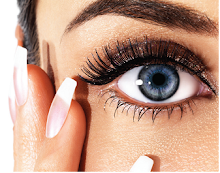APPLIED CORNEA ANATOMY
The cornea is a transparent, avascular, watch-glass like structure. It forms anterior one-sixth of the outer fibrous coat of the eyeball.
Dimensions
The cornea is a transparent, avascular, watch-glass like structure. It forms anterior one-sixth of the outer fibrous coat of the eyeball.
Dimensions
- The anterior surface of cornea is elliptical with an average horizontal diameter of 11.7 mm and vertical diameter of 11 mm.
- The posterior surface of cornea is circular with an average diameter of 11.5 mm.
- Thickness of cornea in the centre is about 0.52 mm while at the periphery it is 0.7 mm.
- Radius of curvature. The central 5 mm area of the cornea forms the powerful refracting surface of the eye. The anterior and posterior radii of curvature of this central part of cornea are 7.8 mm and 6.5 mm, respectively.
- Refractive power of the cornea is about 45 dioptres, which is roughly three-fourth of the total refractive power of the eye (60 dioptres).
Histology
Histologically, the cornea consists of five distinct layers. From anterior to posterior these are: epithelium, Bowman’s membrane, substantia propria (corneal stroma), Descemet’s membrane and endothelium
(Fig. 1).
| FIG 1 Microscopic structure of the cornea |
cells. The deepest (basal) layer is made up of columnar cells, next 2-3 layers of wing or umbrella cells and the most superficial two layers are of flattened cells.
2. Bowman's membrane. This layer consists of a cellular mass of condensed collagen fibrils. It is about 12μm in thickness and binds the corneal stroma
anteriorly with basement membrane of the epithelium. It is not a true elastic membrane but simply a condensed superficial part of the stroma. It shows considerable resistance to infection. But once destroyed, it does not regenerate.
3. Stroma (substantia propria). This layer is about 0.5 mm in thickness and constitutes most of the cornea (90% of total thickness). It consists of collagen
fibrils (lamellae) embedded in hydrated matrix of proteoglycans. The lamellae are arranged in many layers. In each layer they are not only parallel to each
other but also to the corneal plane and become continuous with scleral lamellae at the limbus. The alternating layers of lamellae are at right angle to each other. Among the lamellae are present keratocytes,
wandering macrophages, histiocytes and a few leucocytes.
The Descemet's membrane is a strong homogenous layer which bounds the stroma posteriorly. It is very resistant to chemical agents, trauma and pathological processes. Therefore, 'Descemetocele' can maintain the integrity of eyeball for long. Descemet's membrane consists of collagen and glycoproteins. Unlike Bowman's membrane it can regenerate. Normally it
remains in a state of tension and when torn it curls inwards on itself. In the periphery it appears to end at the anterior limit of trabecular meshwork as
Schwalbe's line (ring).
5. Endothelium. It consists of a single layer of flat polygonal (mainly hexagonal) cells which on slit lamp biomicroscopy appear as a mosaic. The cell density of endothelium is around 3000 cells/mm2 in young adults, which decreases with the advancing age. There is a considerable functional reserve for the endothelium. Therefore, corneal decompensation occurs only after more than 75 percent of the cells are lost. The endothelial cells contain 'active-pump' mechanism.
Blood supply
Cornea is an avascular structure. Small loops derived from the anterior ciliary vessels invade its periphery for about 1 mm. Actually these loops are not in the
cornea but in the subconjunctival tissue which overlaps the cornea.
Nerve supply
Cornea is supplied by anterior ciliary nerves which are branches of ophthalmic division of the 5th cranial nerve. After going about 2 mm in cornea the nerves
lose their myelin sheath and divide dichotomously and form three plexuses — the stromal, subepithelial and intraepithelial.




No comments :
Post a Comment
Waiting for your comments